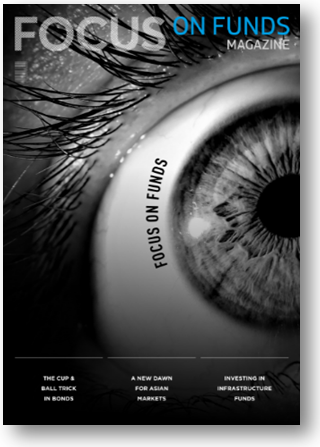May
2020
Focus on Funds: The cup and ball trick in bonds
DIY Investor
25 May 2020
Chief Investment Officer of  RM Funds James Robson wonders if the cup and ball trick has a role to play in modern bond markets with the central banks as the illusionists
RM Funds James Robson wonders if the cup and ball trick has a role to play in modern bond markets with the central banks as the illusionists
One of the oldest conjuring tricks is the cup and balls trick – the basis for the illusion is that the magician makes the balls ‘jump’ from one cup to another by distracting the audience and using two balls.
Perhaps the cup and ball trick have a role to play in the modern bond markets and the central banks are the illusionists: whilst our institutions seek to hold risk free assets, they are distracted from seeing another risk and that is one of interest rate risk.
Both corporate and government bonds price off the ‘risk-free rate’ or the government bond curve: the ‘risk-free rate’ actually has two risks – one is credit risk and is therefore deemed to be the ‘risk- free’ element – the second risk is the interest rate risk.
QE has driven yields to such low levels that many fixed income funds which hold corporate or government securities have been focused on the credit element of holding government bonds and largely not the duration risk: yields have been consistently low and in this environment ones eye can easily wander off the ball (excuse the cheap reference back to my illusion analogy).
‘they are distracted from seeing another risk and that is one of interest rate risk’
As an example, a recent bond issue illustrates the new illusion for safety – last month Austria ‘tapped’ or re-opened an existing 98-year bond which offered a yield to investors of 1.2%.
The price was at 154% of face value (154.00 it was issued at 100.00 in September 2017). Since January the price has risen from 120.00 to 163.00. The bond has a fixed coupon of 2.1%.
Just think about that – this security pays 2.1% per year for 98 years and in the two years the price has moved 63%.
To put it another way – if it now has a running yield of circa 1.2% (the coupon divided by the cash price you are paying) you would have made in the last 2 years the same amount as you will earn in the running yield for the next 52 years!
‘you would have made in the last 2 years the same amount as you will earn in the running yield for the next 52 years!’
Any reader would think of government bonds as largely being risk free (aka boring) giving low yields and underpinning a stable portfolio.
Yet this government bond seems to have price moves more akin to equities of hedge funds or dare I say it bitcoin!
Can you imagine the losses that could be inflicted by such securities if the price went down instead of up?
If the ‘normal’ long rates for long dated Austrian government bonds moved to 3 for example the price would more than halve to 71.50. Yes you read that correctly – a modest rise of 195bp in yield (1.95%) would cause the price to drop by 55%.
If you look at it another way the daily changes in price of the Austrian bond usually equates to generally half the annual coupon! For example these are the closing prices for the first week in July for this security with a yield of 1.2%: cash prices: 156.00/155.37/159.69/162.62.
So other than the fact we are making a decision on Day 1 that we would be happy to lose c 40% of our capital over 98 years in return for 2.1% return we have literally no credit risk – I mean it is Austria.
The second risk though is interest rate risk and this can be seen in the bond duration which is the approximate measure of a bond’s price sensitivity to changes in interest rates. This is not necessarily about interest rates moving but the markets perception of where the interest rates will be in the future.
‘we are making a decision on Day 1 that we would be happy to lose c 40% of our capital over 98 years in return for 2.1% return’
Due to the high duration on this Austrian bond this risk is amplified – in fact its duration risk on steroids as its 98 years of future cash flows to discount so even small changes to future interest rate expectations as we can now see make very large changes to the present day value.
The illusion here is that the market is not really picking up how much risk is out there: As we look forwards in time and get our crystal ball out – we dust it down and peer into the glass – I see a situation where we look back and say ECB quantitate easing distorted yields to such low (negative!) levels that fixed income securities saw their yields dragged down as they were perceived to be ‘value’ or ‘safe’ investments.
I have used this Austrian bond to exaggerate the point but really it could apply to any highly rated corporate or government bond with a maturity in excess of 5 years.
Either way to my mind the risk of holding such highly rated and long dated securities farm outweighs the return – when investors wise up to the fact that the safety of government bonds is largely an illusion for anything with a maturity over a few years the markets could become very volatile.
James Robson is co portfolio manager at RM Secured Direct Lending Plc and VT RM Alternative Income.
To buy this fund click to login to your EQi account and select from:
RM Alternative Income Fund:
Retail Class Accumulation – GB00BYVZQ252
Retail Class Income – GB00BYVZPZ16
RM Direct Lending Fund:
Ordinary – GB00BYMTBG55
Zero Dividend Preference Shares – GB00BG1TSQ91
Click to view
First published in August 2019
Commentary » Investment trusts Commentary » Investment trusts Latest » Latest » Mutual funds Commentary » Mutual funds Latest


Leave a Reply
You must be logged in to post a comment.